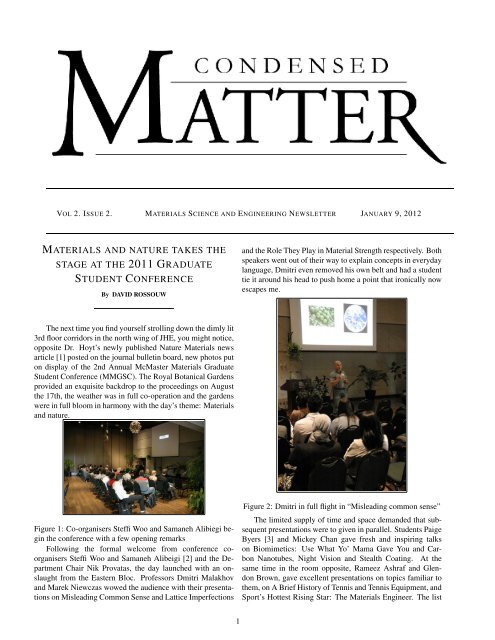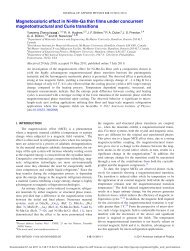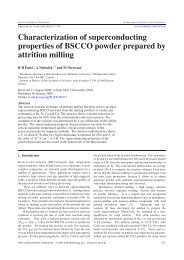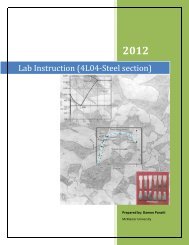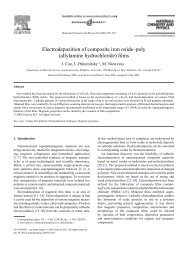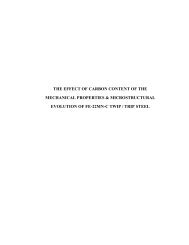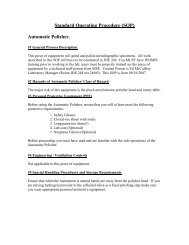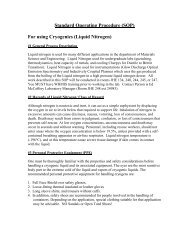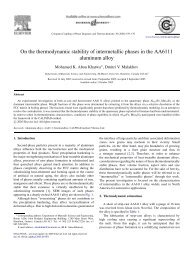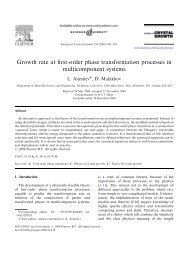December 2011 - McMaster Department of Materials Science and ...
December 2011 - McMaster Department of Materials Science and ...
December 2011 - McMaster Department of Materials Science and ...
Create successful ePaper yourself
Turn your PDF publications into a flip-book with our unique Google optimized e-Paper software.
VOL 2. ISSUE 2. MATERIALS SCIENCE AND ENGINEERING NEWSLETTER JANUARY 9, 2012<br />
MATERIALS AND NATURE TAKES THE<br />
STAGE AT THE <strong>2011</strong> GRADUATE<br />
STUDENT CONFERENCE<br />
By DAVID ROSSOUW<br />
The next time you find yourself strolling down the dimly lit<br />
3rd floor corridors in the north wing <strong>of</strong> JHE, you might notice,<br />
opposite Dr. Hoyt’s newly published Nature <strong>Materials</strong> news<br />
article [1] posted on the journal bulletin board, new photos put<br />
on display <strong>of</strong> the 2nd Annual <strong>McMaster</strong> <strong>Materials</strong> Graduate<br />
Student Conference (MMGSC). The Royal Botanical Gardens<br />
provided an exquisite backdrop to the proceedings on August<br />
the 17th, the weather was in full co-operation <strong>and</strong> the gardens<br />
were in full bloom in harmony with the day’s theme: <strong>Materials</strong><br />
<strong>and</strong> nature.<br />
Figure 1: Co-organisers Steffi Woo <strong>and</strong> Samaneh Alibiegi begin<br />
the conference with a few opening remarks<br />
Following the formal welcome from conference coorganisers<br />
Steffi Woo <strong>and</strong> Samaneh Alibeigi [2] <strong>and</strong> the <strong>Department</strong><br />
Chair Nik Provatas, the day launched with an onslaught<br />
from the Eastern Bloc. Pr<strong>of</strong>essors Dmitri Malakhov<br />
<strong>and</strong> Marek Niewczas wowed the audience with their presentations<br />
on Misleading Common Sense <strong>and</strong> Lattice Imperfections<br />
1<br />
<strong>and</strong> the Role They Play in Material Strength respectively. Both<br />
speakers went out <strong>of</strong> their way to explain concepts in everyday<br />
language, Dmitri even removed his own belt <strong>and</strong> had a student<br />
tie it around his head to push home a point that ironically now<br />
escapes me.<br />
Figure 2: Dmitri in full flight in “Misleading common sense”<br />
The limited supply <strong>of</strong> time <strong>and</strong> space dem<strong>and</strong>ed that subsequent<br />
presentations were to given in parallel. Students Paige<br />
Byers [3] <strong>and</strong> Mickey Chan gave fresh <strong>and</strong> inspiring talks<br />
on Biomimetics: Use What Yo’ Mama Gave You <strong>and</strong> Carbon<br />
Nanotubes, Night Vision <strong>and</strong> Stealth Coating. At the<br />
same time in the room opposite, Rameez Ashraf <strong>and</strong> Glendon<br />
Brown, gave excellent presentations on topics familiar to<br />
them, on A Brief History <strong>of</strong> Tennis <strong>and</strong> Tennis Equipment, <strong>and</strong><br />
Sport’s Hottest Rising Star: The <strong>Materials</strong> Engineer. The list
goes on [4]. For me, one <strong>of</strong> the day’s memorable moments<br />
occurred in the afternoon c<strong>of</strong>fee break. Feihong Nan delighted<br />
the audience with her musical talent playing the Zither, a traditional<br />
Chinese instrument. The authentic sounds from the instrument<br />
were complemented by the s<strong>of</strong>t patter <strong>of</strong> water falling<br />
from a distant fountain. The musical experience was complete<br />
with the recognizable Western tune Jingle Bells.<br />
The conference wrapped up with Engineering Physics’<br />
John Preston. His talk on The Role <strong>of</strong> Epitaxy in Nanotechnology<br />
inspired a wave <strong>of</strong> questions from the audience.<br />
Mahshid Fathi won the very competitive battle for this year’s<br />
best speaker award for her talk on Research <strong>and</strong> Teamwork.<br />
Although in retrospect, all participants were rewarded with a<br />
full day <strong>of</strong> presentations, ideas, food, entertainment, materials<br />
<strong>and</strong> nature.<br />
Figure 3: Feihong Nan plays the zither in the afternoon break<br />
Co-organisers Steffi Woo <strong>and</strong> Samaneh Alibeigi were delighted<br />
with how the conference went. “Hearing the oohh’s<br />
<strong>and</strong> aahh’s <strong>of</strong> the attendees as they were entering the conference<br />
hall <strong>and</strong> the serene courtyard” was one <strong>of</strong> Steffi’s<br />
favourite moments <strong>of</strong> the day, “A lot <strong>of</strong> people were not familiar<br />
with the Royal Botanical Gardens, so it was a little unexpected.”<br />
Samaneh was impressed with the variety <strong>of</strong> fields<br />
represented at the conference, “I could see the bonding that<br />
<strong>Materials</strong> <strong>Science</strong> <strong>and</strong> Engineering had with different fields<br />
such as physics, chemistry, mechanical, civil, medicine, sport<br />
<strong>and</strong> art.” When asked what was learned from organising the<br />
conference, Steffi reflects In the process <strong>of</strong> getting people to<br />
give a talk at the conference or display some <strong>of</strong> their outside<br />
talents, I learned a bit about how they spend their time outside<br />
<strong>of</strong> their research, what they do for fun. So many <strong>of</strong> them are<br />
so talented in music <strong>and</strong> the arts, it is really great!<br />
The organisers would like to thank the <strong>Materials</strong> department,<br />
in particular, Nik Provatas, who inspired the idea <strong>of</strong> a<br />
student organized conference. Also many thanks go to Jane,<br />
Diana <strong>and</strong> Nanci for their guidance <strong>and</strong> patience, <strong>and</strong> Ed for<br />
technical support.<br />
[1] Hoyt, J. Metallic alloys: All particles are equal. Nature<br />
<strong>Materials</strong> 10, 652653 (<strong>2011</strong>).<br />
[2] Conference organisers: Steffi Woo, Samaneh Alibeigi,<br />
Stephen Jones <strong>and</strong> David Rossouw.<br />
[3] Former best speaker award winner.<br />
[4] A list <strong>of</strong> all the talks <strong>and</strong> abstracts can be<br />
found at http://mselx<strong>of</strong>f.mcmaster.ca/party/<br />
MEGSC<strong>2011</strong>/index.html<br />
2<br />
MAC MSE PHYSICS CORNER: REAL<br />
FRACTALS AND SOME APPLICATIONS<br />
By JONATHAN STOLLE<br />
In the last article on fractals, we introduced fractals <strong>and</strong><br />
a description <strong>of</strong> fractal dimensions. These objects (geometric<br />
fractals) might seem rather simplistic to be <strong>of</strong> any use in real<br />
problems for a couple <strong>of</strong> reasons:<br />
i) they are geometrically very regular<br />
ii) they are assume that the pattern is repeated to infinitely<br />
small scales (which would suggest having a self-similar pattern<br />
smaller than an atom, for example)<br />
In contrast to geometric fractals, the most useful fractals<br />
are statistically self-similar (or self-affine) ones, where various<br />
geometric properties taken into account in a statistical (r<strong>and</strong>om)<br />
sense can be related to power laws over a limited range<br />
<strong>of</strong> scales (i.e., assigning a fractal dimension to an object over a<br />
certain range <strong>of</strong> scales). Some properties <strong>of</strong> infinite fractals relate<br />
to these objects very well (even if the self-similarity only<br />
happens over a scale <strong>of</strong> 100 or so). (See [1] for more details.)<br />
Perhaps the most famous example <strong>of</strong> a self-similar object is<br />
the coastline, whose self-similar behaviour was originally observed<br />
by Lewis Fry Richardson <strong>and</strong> later described by M<strong>and</strong>elbrot<br />
in relation to fractals. Different coastlines have different<br />
fractal dimensions; some are very tortuous, like Norway,<br />
while others are smooth, like South Africa, which has a fractal<br />
dimension <strong>of</strong> 1 [2]. In Fig. 1, how to estimate the coastline<br />
<strong>of</strong> Great Britain is shown. If the same physical processes are<br />
responsible for creating coastlines in various places on earth,<br />
one might wonder how this can be accounted for. The causes<br />
for this have recently been looked at again in Physical Review<br />
E; see [4] for a synopsis. One way is by accepting the claim<br />
that we are only looking at statistically self-similar fractals, so<br />
different parts might exhibit very different behaviour, but there<br />
is more.<br />
Figure 1: Coastline <strong>of</strong> Great Britain [3]<br />
Instead <strong>of</strong> looking at curves/surfaces as just isolated geometric<br />
sets, one can look at these objects as sets embedded<br />
in a higher-dimensional function function (for example, level
curves <strong>of</strong> a surface). Each level curve can then have a fractal<br />
dimension associated with it. If it causes some discomfort<br />
that the functions are very irregular, a good example function<br />
displaying fractal behaviour is the Weierstrass function<br />
(In Fig. 2). Objects in which all level curves display the same<br />
fractal dimension are mon<strong>of</strong>ractals <strong>and</strong> the generalization in<br />
which different level curves have different fractal dimensions<br />
are known as multifractals.<br />
Figure 2: Weierstrass Function [5]<br />
Clouds, the structure <strong>of</strong> foams, fluid turbulence, <strong>and</strong> stock<br />
market prices can all to some degree be described by these<br />
general fractal objects (Fig. 3). A little closer to home, you<br />
can find a number <strong>of</strong> applications in materials science: 2nd order<br />
phase transitions (e.g., spinodal decomposition) can lead to<br />
critical opalescence, flocculation, <strong>and</strong> fractal dendrites. There<br />
are also applications in biology, when looking at shape <strong>of</strong> the<br />
kidney or the shape <strong>of</strong> neuronal connections.<br />
(a) Stock Prices Indices<br />
(do these not look like Weierstrass functions?) [6]<br />
(b) simulated clouds where fractality is<br />
promoted by air turbulence [7]<br />
3<br />
Figure 3: Practical uses <strong>of</strong> fractals<br />
Before the next article, why not look at a bunch <strong>of</strong> satellite<br />
images <strong>and</strong> try to identify fractal patterns in them? In the next<br />
article, I will mention more about the mathematical properties<br />
<strong>of</strong> these objects <strong>and</strong> how they relate to chaos.<br />
[1] H. Juergens, H. O. Peitgen, <strong>and</strong> D. Saupe. Chaos <strong>and</strong><br />
Fractals: New Frontiers <strong>of</strong> <strong>Science</strong>. Springer-Verlag, New<br />
York, 1992.<br />
[2] Benot M<strong>and</strong>elbrot, 1967, How Long Is the Coast <strong>of</strong><br />
Britain? Statistical Self-Similarity <strong>and</strong> Fractional Dimension.<br />
<strong>Science</strong>, New Series, Vol. 156, No. 3775. (May<br />
5, 1967), pp. 636-638. doi:10.1126/science.156.3775.636<br />
or http://users.math.yale.edu/˜bbm3/web_<br />
pdfs/howLongIsTheCoastOfBritain.pdf<br />
[3] http://commons.wikimedia.org/wiki/<br />
File:Britain-fractal-coastline-combined.<br />
jpg (Arrived by clicking on various links from<br />
http://en.wikipedia.org/wiki/How_Long_<br />
Is_the_Coast_<strong>of</strong>_Britain%3F_Statistical_<br />
Self-Similarity_<strong>and</strong>_Fractional_Dimension<br />
)<br />
[4] SynopsisPhysics Stormy seas. http://physics.<br />
aps.org/synopsis-for/10.1103/PhysRevE.84.<br />
016102<br />
[5] Weierstrass function: http://mathworld.<br />
wolfram.com/WeierstrassFunction.html<br />
[6] StockMarket:http://en.wikipedia.org/<br />
wiki/Stock_market<br />
[7] Fractal Clouds: StockMarket:http://davis.<br />
wpi.edu/˜matt/courses/fractals/clouds.<br />
html<br />
THE UNDERGRAD UPDATE (OCTOBER<br />
<strong>2011</strong>)<br />
By BEN DESCOULDS<br />
The start <strong>of</strong> the year has brought new <strong>and</strong> improved department<br />
events from the <strong>Materials</strong> Council. The first event, <strong>Materials</strong><br />
<strong>Department</strong> Welcome Back Night, was a huge success!<br />
Dr. Provatas led <strong>of</strong>f the night welcoming everyone back <strong>and</strong><br />
the rest <strong>of</strong> the pr<strong>of</strong>essors introduced themselves <strong>and</strong> wished all<br />
the undergrads the best <strong>of</strong> luck in the coming year. A short presentation<br />
announced the new undergrad labs <strong>and</strong> study rooms<br />
in the basement <strong>of</strong> JHE. Dr. Zurob finished <strong>of</strong>f the night by<br />
getting everyone excited about the France Exchange. When<br />
the pizza came out, the upper years were able to share their<br />
experiences with the new 2nd years <strong>and</strong> really let them know<br />
how fun <strong>and</strong> awesome it is to be part <strong>of</strong> <strong>Materials</strong> Engineering.<br />
Thanks to everyone who came out, it was a great night. Special<br />
thanks to Diana for organizing the event. If you were not<br />
able to make it out, there will be many more events happening<br />
during the rest <strong>of</strong> the year.
Upcoming Events:<br />
• UBC Night October 26th<br />
• <strong>Materials</strong> T-Shirt Sales Coming soon<br />
• Industry Night November 24th<br />
• End <strong>of</strong> term Buffet <strong>December</strong> 2nd<br />
The <strong>Materials</strong> S<strong>of</strong>tball team, Petric’s Peritectics, started <strong>of</strong>f<br />
the season with a bang! They won their pre-season game on<br />
the strength <strong>of</strong> three homeruns by Captain Kyle Cormier. With<br />
a complete team effort, they continued their success in the first<br />
game <strong>of</strong> the season <strong>and</strong> demolished their opponent by 20 runs.<br />
The second game ended in a loss, but highlights <strong>of</strong> the game included<br />
Pierre Le-Dreff Kerwin’s acrobatic catch in centre field<br />
<strong>and</strong> Jordan McClanahan’s diving tag at second base. Game 3<br />
was played in the freezing cold <strong>and</strong> rain, but the team battled<br />
through the elements <strong>and</strong> came out with the win. The <strong>of</strong>fense<br />
4<br />
was firing on all cylinders <strong>and</strong> Brycklin Wilson was a defensive<br />
star at first base. Mary Gallerneault also gunned an opposing<br />
player out at second base from right field. Special mention<br />
goes out to Kevin Crooks’ incredible batting average <strong>of</strong> 1.000<br />
on the season. Petric’s Peritectics are looking to continue their<br />
excellent season into the second half!<br />
MATERIALS IN THE MATERIAL WORLD<br />
By AHMED SALMAN<br />
The worlds <strong>of</strong> engineering <strong>and</strong> fashion design have traditionally<br />
been thought <strong>of</strong> as being completely independent<br />
<strong>and</strong> mutually exclusive. The delicate <strong>and</strong> feathery chiffons<br />
<strong>and</strong> satins could not be further away in texture, appearance,<br />
or fabrication from the rugged, invulnerable metals <strong>and</strong> steels.<br />
However, in their quest for developing the hottest new trends,<br />
fashion designers are stumbling upon some <strong>of</strong> the most notorious<br />
<strong>and</strong> widely used engineering materials, <strong>and</strong> are using them<br />
in ingenuous ways to create masterful showpieces.<br />
In the 1927 German silent film Metropolis, an inventor<br />
with the intentions <strong>of</strong> destroying the world transforms the leading<br />
female character, Maria, into a robot. This film represented<br />
one <strong>of</strong> the first appearances <strong>of</strong> a robot-human hybrid. Noted<br />
as a source <strong>of</strong> inspiration for many sci-fi writers <strong>and</strong> costume<br />
designers, as well as fashion designers throughout the ages,<br />
Walter Schultze-Mittendorf designed Marias bodysuit out <strong>of</strong> a<br />
“plastic wood” which was molded to perfectly match the actresss<br />
proportions. It was then painted with a mixture <strong>of</strong> silver<br />
<strong>and</strong> bronze to achieve a metallic appearance. This robotic inspiration<br />
appeared on the runways first in 1995 when iconic<br />
French fashion designer Thierry Mugler designed a bodysuit<br />
<strong>of</strong> chrome plated fiberglass with clear polymethyl acrylate<br />
“cut-outs” strategically placed to compliment the female figure.<br />
While these creations are mostly viewed as elaborate yet<br />
unwearable art pieces, they have inspired many <strong>of</strong> today’s top<br />
fashion designers who have been very successful in designing<br />
ready to wear garments out <strong>of</strong> these unconventional materials.<br />
A great example <strong>of</strong> this is a corset made <strong>of</strong> coiled aluminum<br />
designed by late British designer Alex<strong>and</strong>er McQueen. The<br />
risk-taking designer also created a more provocative anatomically<br />
correct aluminum corset inspired by the human spine <strong>and</strong><br />
rib cage.<br />
Designers have also chosen to work with more difficult engineering<br />
materials such as ceramics <strong>and</strong> glasses. Beijing artist<br />
Li Xia<strong>of</strong>eng <strong>and</strong> Japanese artist Makiko Nakamura were both<br />
inspired by traditional ceramics in their designs. While far<br />
from being ready to wear, these spectacular showpieces leave<br />
much to be desired from the world <strong>of</strong> ceramics.
Figure 1: Schultze-Mittendorf’s Maria.<br />
Other designers have collaborated with engineers <strong>and</strong> scientists<br />
to create altogether new materials with potential uses<br />
in the fashion industry. In 1995, Dr. Manel Torres, a fashion<br />
designer from the Imperial College <strong>of</strong> London developed<br />
a colloidal suspension <strong>of</strong> cotton fibers dissolved in a solvent<br />
which allows the cotton to be sprayed from an aerosol can.<br />
Once sprayed, the solvent evaporates <strong>and</strong> a layer <strong>of</strong> cotton perfectly<br />
matching the persons silhouette remains. Such a design<br />
is revolutionary in concept as it conjures up the ideas <strong>of</strong> instant<br />
fashion <strong>and</strong> reusable material; the cotton can be dissolved once<br />
again in the solvent <strong>and</strong> used to create a different article <strong>of</strong><br />
clothing. In addition, it allows for the incorporation <strong>of</strong> scents<br />
<strong>and</strong> dyes for versatility.<br />
5<br />
Figure 2: Mugler’s Robot remodeled in gold.<br />
Figure 3: “Coiled” by Shaun Leanne for Alex<strong>and</strong>er McQueen,<br />
Aluminum.<br />
Another spectacular creation is that <strong>of</strong> Suzanne Lee, a London<br />
based fashion designer who has been able to “grow” her<br />
own clothes. By fermenting a sugar syrup mixture to create<br />
cellulose, she has been successful in creating reusable fabric
that dissolves in water. While some obvious issues are presented,<br />
the potential <strong>of</strong> this design process, which is still in the<br />
early stages <strong>of</strong> development, is staggering. As clothes go out<br />
<strong>of</strong> style at the end <strong>of</strong> a season, clothing retailers can use dmod<br />
pieces as the raw materials for creating new trendy clothes.<br />
Figure 4: Bodice by Nakamura for McQueen, Ceramic.<br />
On a different yet equally remarkable note, another design<br />
6<br />
concept that presents tremendous opportunities for the future<br />
<strong>of</strong> the fashion industry is the idea <strong>of</strong> coating cotton fibers with<br />
carbon nanotubes. Engineers have been successful in creating<br />
fabric from these coated fibers <strong>and</strong> have found them to be electrically<br />
conductive, which has allowed for endless opportunities<br />
<strong>of</strong> functional design. Antibodies have been incorporated<br />
within the nanotubes, which detect blood <strong>and</strong> could have applications<br />
in military wear. In addition, these antibodies are<br />
capable <strong>of</strong> detecting allergens <strong>and</strong> could signal warnings for<br />
the wearer.<br />
Truly, the opportunities for collaboration between engineering<br />
<strong>and</strong> fashion design are limitless. From bio-inspired<br />
garments to recycled eco-friendly designs, <strong>and</strong> even clothes<br />
that reflect the wearers emotional state, the future <strong>of</strong> fabric design<br />
is strongly linked to advances in materials science. It has<br />
really never been more fashionable to be a materials scientist.<br />
Figure 5: Biobomber Jacket by Suzanne Lee, Cellulose.


